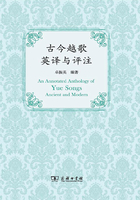
Comments and Annotations
The myth of Pangu (creator of the world), passed on orally from generation to generation, is one of antiquity. The earliest account about it is generally attributed to Chronicle Dating from the Three Kings and the Five Emperors (《三五历纪》),which was edited by Xu Zheng (徐整,?-?) et al. during the period of the Three Kingdoms (220—280). Though the book is lost,extant documents with relevant citations, such as A Categor-ized Anthology of Literature (《艺文类聚》) compiled by Ouyang Xun (欧阳询, 557-641), can offer some content of the myth, which roughly goes as follows:
In the very beginning, the world was of an egg-shaped chaos, which for 18,000 years had gestated a giant to be known as Pangu. When Pangu became conscious, he found himself surrounded by total darkness, and thus he pulled down a tooth and made an ax of it. He hacked about with his ax until the chaos broke apart, when what was light floated up to be the sky and what was heavy settled down to be Earth. For another 18,000 years the sky had become very very high, the heaviness had grown very very thick, and Pangu had grown very very tall. When he passed away, his eyes, hair, blood vessels, and limbs, etc., respectively became the sun, the moon, the forests, the rivers and mountains ...
Many nationalities in southern China regard Pangu as their ancestor, and there are memorial halls, memorial monuments and temples (such as the one in Guilin of Guangxi) built in commemoration of Pangu.
The present song of the Zhuang Nationality, which provides a different version of the myth, is taken from History of the Zhuang Nationality (《壮族通史》) compiled by Huang Xianfan (黄现璠). It narrates how Pangu creats the world and expresses people’s gratitude to Pangu. The device of repetition (the first line of each stanza) serves to emphasize the glorification.
This song is arranged as the first in this book not because of its date of creation, but because of the age of the event to which it relates.